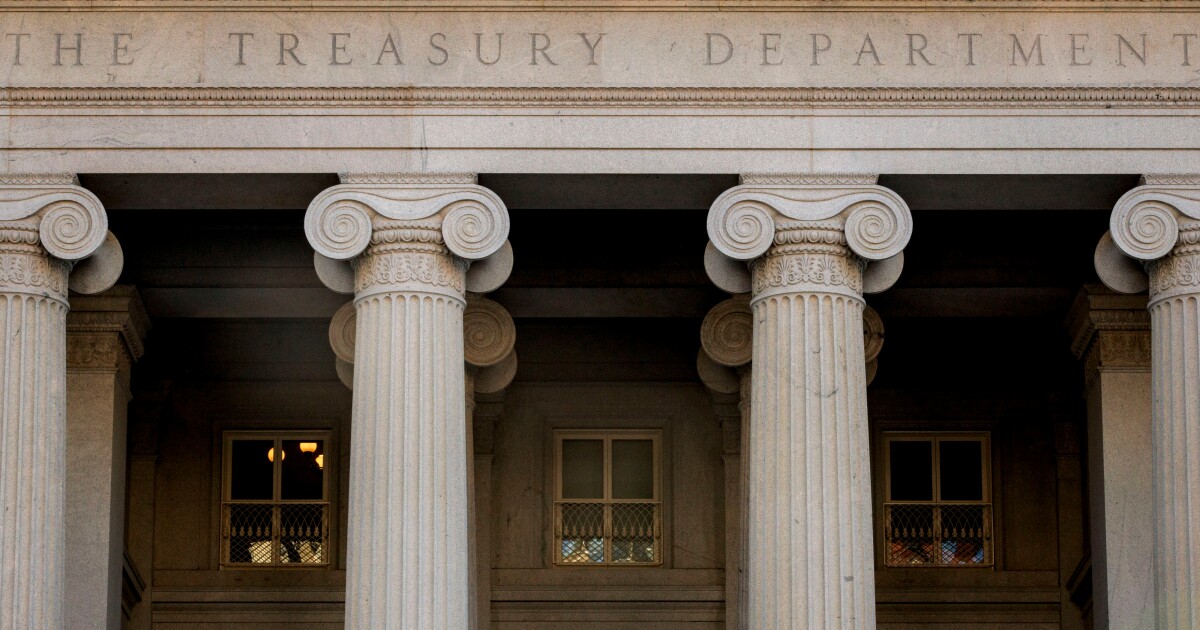The Treasury Department announced it would no longer enforce the Corporate Transparency Act, nor enforce any penalties or fines associated with beneficial ownership reporting under the existing regulatory deadlines.
The Treasury also said Sunday it would not enforce any penalties or fines against U.S. citizens or domestic reporting companies or their beneficial owners after forthcoming rule changes take effect either. The Treasury plans to issue a proposed rulemaking that would narrow the scope of the rule to foreign reporting companies only. The Treasury said it’s taking this step “in the interest of supporting hard-working American taxpayers and small businesses and ensuring that the rule is appropriately tailored to advance the public interest.”
“This is a victory for common sense,” said Treasury Scott Bessent in a statement Sunday. “Today’s action is part of President Trump’s bold agenda to unleash American prosperity by reining in burdensome regulations, in particular for small businesses that are the backbone of the American economy.”
The CTA was signed into law as part of the National Defense Authorization Act of 2021 and requires individuals with an ownership interest in a limited liability company to disclose personal data to the Treasury Department’s Financial Crimes Enforcement Network as a way to deter illicit activity such as money laundering, tax fraud, drug trafficking and terrorism financing by anonymous shell companies. Failure to comply could result in up to two years of jail time and a $10,000 fine per violation.
The law has been the subject of a series of lawsuits that have gone back and forth in recent months, leaving businesses unsure of whether they needed to comply. The law was support to take effect for new businesses on Jan. 1, 2024 and for existing businesses on Jan. 1, 2025, but that deadline has been pushed back as a result of the court appeals. Last month, a federal appeals court in Texas lifted an injunction in one case after the Supreme Court granted a stay in an injunction in a different Texas case in January. After last month’s decision, FinCEN extended the reporting deadline by 30 days until March 21, 2025 for most companies and announced its intention to revise the reporting rule.
Last week, FinCEN confirmed that it would “not issue any fines or penalties or take any other enforcement actions against any companies based on any failure to file or update beneficial ownership information (BOI) reports pursuant to the [CTA] by the current deadlines,” essentially pausing CTA compliance for all covered entities indefinitely.
“FinCEN finally did the right thing and hit the reset button on CTA compliance,” said Joseph Lynyak, a banking partner at the law firm Dorsey & Whitney, in a statement Friday. “Besides the current overhang of litigation challenging the CTA regulations, FinCEN’s responses to injunctions issued by courts arising from that litigation compounded confusion regarding compliance. For example, indicating that reporting entities had approximately 30 days to complete initial filings was both naive and impractical. Further, although FinCEN has repeatedly indicated that completing beneficial ownership reports was a simple matter, legal practitioners have filed numerous requests for interpretative guidance that generally has been ignored.”
The move by the Treasury Department to no longer enforce the Corporate Transparency Act was criticized by corporate transparency advocates.
“With one tweet, the Administration has contradicted 15 years of bipartisan work by Congress to end the scourge of anonymous shell companies — which are a favorite tool of our nation’s global adversaries and criminals including fentanyl traffickers, money launderers, and tax cheats,” said Ian Gary, executive director of the FACT Coalition, in a statement Monday. “Hollowing out the Corporate Transparency Act is an unconstitutional subversion of Congress’ intent that will not survive judicial scrutiny.”
“This decision threatens to make the United States a magnet for foreign criminals, from drug cartels to fraudsters to terrorist organizations,” said Scott Greytak, director of advocacy for Transparency International U.S., the U.S. branch of the world’s oldest and largest anticorruption organization, in a statement. “Inexplicably, it tells foreign criminals–fentanyl traffickers, illegal arms dealers, corrupt foreign officials—that they can evade the most powerful anti-money laundering law passed since the PATRIOT Act by choosing to set up their criminal operations inside the United States.”
He pointed out that the U.S.’s national security, intelligence, and law enforcement communities strongly supported the bipartisan Corporate Transparency Act because it stopped criminals from hiding behind anonymous shell companies, regardless of where those companies happened to be formed
“Now, criminals can evade this national security law by simply starting and running those front companies inside the United States,” Gretak added. “A notorious Chinese drug trafficking organization, for example, used front companies formed in Massachusetts to distribute deadly fentanyl analogues and 250 other drugs to some 37 U.S. states. Anonymous companies in the U.S. have also been used by Iran to evade sanctions and by terrorist-affiliated groups to gain access to U.S. defense contracts.”
He anticipates that criminals will exploit the loophole by relocating to the U.S.
“Narrowing the scope of the Corporate Transparency Act to exclude U.S.-based companies creates a clear loophole for criminals to exploit, and risks making the U.S. a haven for illicit financial activity,” Greytak added. “It also ensures that the United States will be found noncompliant with baseline, globally accepted anti-money laundering and counter-financing of terrorism standards. We emphatically urge the U.S. Treasury Department to reverse this decision with expediency.”
Small businesses were seen as being subjected to unnecessary and onerous reporting requirements by the CTA, but they might be harmed by nonenforcement, according to one small business advocacy group.
“Small businesses suffer when they are forced to compete with fraudulent and criminal enterprises that exploit anonymous shell corporations to evade accountability,” said Richard Trent, Executive Director of the small business network Main Street Alliance, in a statement. “The Trump Administration’s reckless efforts to undermine the Corporate Transparency Act’s beneficial ownership reporting requirements threaten to roll back critical protections. Weakening these rules would allow bad actors to continue exploiting loopholes, harming honest small business owners and distorting the marketplace in favor of corruption. That’s why MSA stands firmly in defense of transparency and fairness—because Main Street businesses deserve better.”
Sen. Ron Wyden, D-Oregon, the top Democrat on the Senate Finance Committee, also criticized the move. “The takeaway here is that Trump is a rich financial criminal, and he’s running his administration for the benefit of other rich financial criminals,” Wyden said in a statement Monday. “In particular, this is another gift to shadowy Russian oligarchs and money launderers, who have a lot of reasons to celebrate these days thanks to Donald Trump.”


 Economics1 week ago
Economics1 week ago
 Economics1 week ago
Economics1 week ago
 Economics5 days ago
Economics5 days ago
 Finance1 week ago
Finance1 week ago
 Economics1 week ago
Economics1 week ago
 Blog Post6 days ago
Blog Post6 days ago
 Personal Finance6 days ago
Personal Finance6 days ago
 Finance6 days ago
Finance6 days ago












